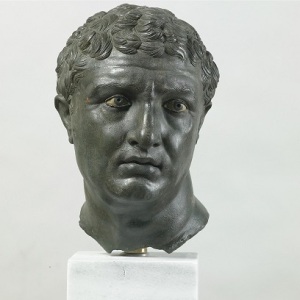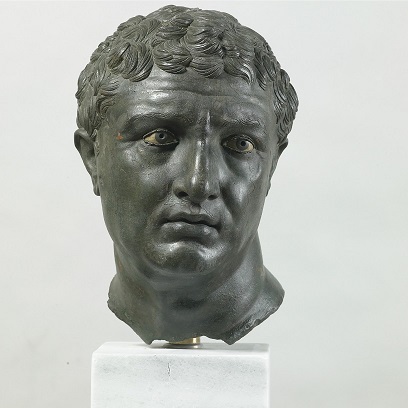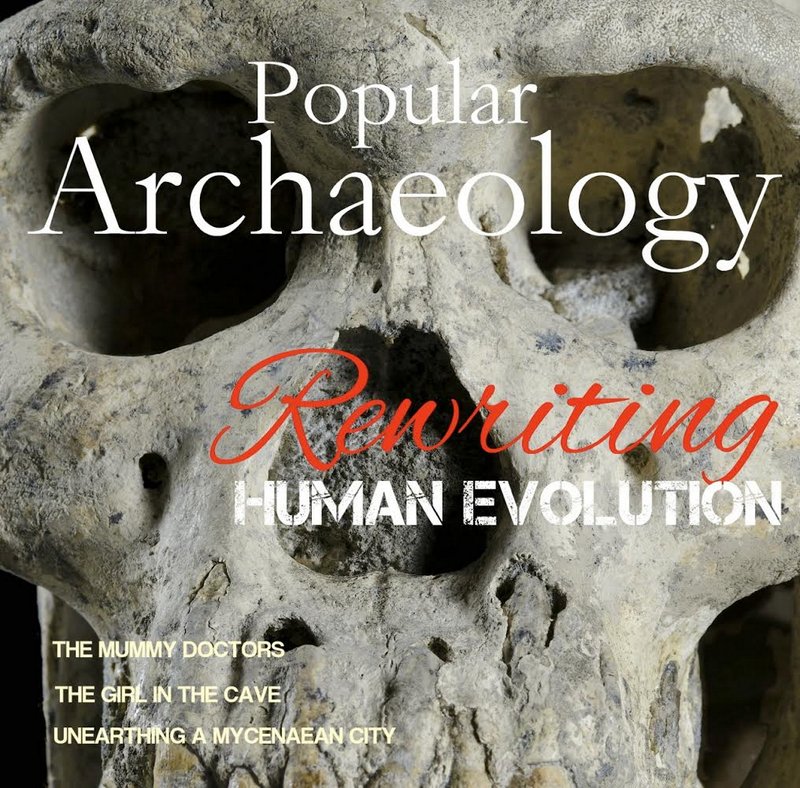 Greek art: Head of a man, c. 100 b.C., from Delos. Athens, National Archaeological Museum Bronze. 1ft 1 in (cm 33).- *** Permission for usage must be provided in writing from Scala. ***
Greek art: Head of a man, c. 100 b.C., from Delos. Athens, National Archaeological Museum Bronze. 1ft 1 in (cm 33).- *** Permission for usage must be provided in writing from Scala. *** Beginning in March 2015, the Palazzo Strozzi, Florence; the J. Paul Getty Museum, Los Angeles; and the National Gallery of Art, Washington, D.C., will present Power and Pathos: Bronze Sculpture of the Hellenistic World, the first major international exhibition to bring together approximately 50 ancient bronzes from the Mediterranean region and beyond ranging from the 4th century B.C. to the 1st century A.D.
During the Hellenistic era, artists around the Mediterranean created innovative, realistic sculptures of physical power and emotional intensity. Bronze—with its reflective surface, tensile strength, and ability to hold the finest details—was employed for dynamic compositions, graphic expressions of age and character, and dazzling displays of the human form.
From sculptures known since the Renaissance, such as the Arringatore (Orator) from Sanguineto (in the collection of the Museo Archeologico Nazionale, Florence), to spectacular recent discoveries that have never before been exhibited in the United States, the exhibition is the most comprehensive museum survey of Hellenistic bronzes ever organized. In each showing of the exhibition, recent finds—many salvaged from the sea—will be exhibited for the first time alongside well-known works. The works of art on view will range in scale from statuettes, busts and heads to life-size figures and herms. Just one example, illustrated below right, is the bronze Portrait of a Man, dated to 100 BC.*
 Power and Pathos: Bronze Sculpture of the Hellenistic World is especially remarkable for bringing together works of art that, because of their rarity, are usually exhibited in isolation. When viewed in proximity to one another, the variety of styles and techniques employed by ancient sculptors is emphasized to greater effect, as are the varying functions and histories of the bronze sculptures.
Power and Pathos: Bronze Sculpture of the Hellenistic World is especially remarkable for bringing together works of art that, because of their rarity, are usually exhibited in isolation. When viewed in proximity to one another, the variety of styles and techniques employed by ancient sculptors is emphasized to greater effect, as are the varying functions and histories of the bronze sculptures.
Bronze was a material well-suited to reproduction, and the exhibition provides an unprecedented opportunity to see objects of the same type, and even from the same workshop, together for the first time.
The travel schedule for Power and Pathos: Bronze Sculpture of the Hellenistic World is:
- Palazzo Strozzi, Florence, Italy
March 14 – June 21, 2015
www.palazzostrozzi.org
- J. Paul Getty Museum, Los Angeles, CA
July 28 – November 1, 2015
www.getty.edu
- National Gallery of Art, Washington, D.C.
December 6, 2015 – March 20, 2016
www.nga.gov
This exhibition is curated by Jens Daehner and Kenneth Lapatin of the J. Paul Getty Museum and co-organized by the J. Paul Getty Museum, Los Angeles; the Fondazione Palazzo Strozzi, Florence; and the National Gallery of Art, Washington, D.C.; with the participation of Soprintendenza per i Beni Archeologici della Toscana. It is supported by an indemnity from the Federal Council on the Arts and the Humanities.
Bank of America is the National Presenting Sponsor of this exhibition. The Los Angeles presentation is also supported by the Getty Museum’s Villa Council.
________________________________________________
The J. Paul Getty Trust is an international cultural and philanthropic institution devoted to the visual arts that includes the J. Paul Getty Museum, the Getty Research Institute, the Getty Conservation Institute, and the Getty Foundation. The J. Paul Getty Trust and Getty programs serve a varied audience from two locations: the Getty Center in Los Angeles and the Getty Villa in Malibu.
The J. Paul Getty Museum collects in seven distinct areas, including Greek and Roman antiquities, European paintings, drawings, manuscripts, sculpture and decorative arts, and photographs gathered internationally. The Museum’s mission is to make the collection meaningful and attractive to a broad audience by presenting and interpreting the works of art through educational programs, special exhibitions, publications, conservation, and research.
Visiting the Getty Center
The Getty Center is open Tuesday through Friday and Sunday from 10 a.m. to 5:30 p.m., and Saturday from 10 a.m. to 9 p.m. It is closed Monday and most major holidays. Admission to the Getty Center is always free. Parking is $15 per car, but reduced to $10 after 5 p.m. on Saturdays and for evening events throughout the week. No reservation is required for parking or general admission. Reservations are required for event seating and groups of 15 or more. Please call (310) 440-7300 (English or Spanish) for reservations and information. The TTY line for callers who are deaf or hearing impaired is (310) 440-7305. The Getty Center is at 1200 Getty Center Drive, Los Angeles, California.
Additional information is available at www.getty.edu.
______________________________________________________
*Image: Portrait of a Man, about 100 B.C. Bronze, white paste and dark stone, 32.5 x 22 x 22 cm. Courtesy of the National Archaeological Museum, Athens. Photo: Marie Mauzy/Art Resource, NY
Source: Press release of the J.Paul Getty Museum, Los Angeles, CA.
______________________________________________________
Read about the most fascinating discoveries with a premium subscription to Popular Archaeology Magazine. Find out what Popular Archaeology Magazine is all about. AND MORE:
On the go? Get the smartphone version of Popular Archaeology as an app or as an ebook.
Just released!
The special new premium quality print edition of Popular Archaeology Magazine. A beautiful volume for the coffee table.
Travel and learn with Far Horizons.
____________________________________________
Popular Archaeology’s annual Discovery Edition eBook is a selection of the best stories published in Popular Archaeology Magazine in past issues, with an emphasis on some of the most significant, groundbreaking, or fascinating discoveries in the fields of archaeology and paleoanthropology and related fields. At least some of the articles have been updated or revised specifically for the Discovery edition. We can confidently say that there is no other single issue of an archaeology-related magazine, paper print or online, that contains as much major feature article content as this one. The latest issue, volume 2, has just been released. Go to the Discovery edition page for more information.









